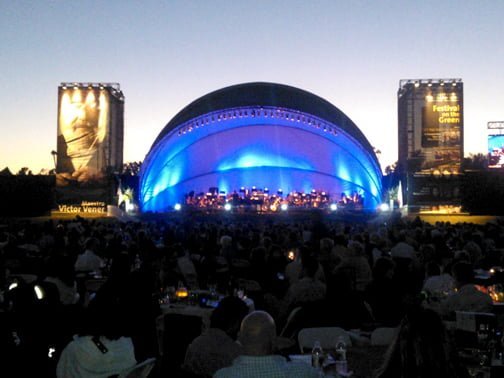
By Ted AYALA
As fireworks whizzed and cracked in the night sky above and the USC Trojan Marching Band took the stage and added their powerful brasses to the closing bars of “Stars and Stripes Forever,” one thing became clear for the California Philharmonic and their music director Victor Vener: it was good to be home.
It was only last year that the orchestra abruptly terminated its 16-year relationship with the Los Angeles County Arboretum. But the orchestra, like everything in life, moved on – in this case to a new amphitheatre built on the track of Santa Anita. With the stars glimmering above and large crowds of music lovers eagerly cheering the orchestra, Cal Phil has settled into its new home with an ease and familiarity that gave the appearance as if it had always been there.
Opening with a square-jawed – if at times long-breathed – rendition of Shostakovich’s 1954 “Festive Overture,” the orchestra set the evening in motion with playing of great heft and sturdiness.
Hefty and sturdy is an apt description of its way with the work that followed, Smetana’s “Vltava” from “Má vlast.” The waters of the Moldau ebbed more portentously in Vener’s hands, its waves rolling thick and heavy across its banks.
An interlude of pop music, by way of singer Vanessa Carlton, followed, with a handful of songs that that served as a showcase of her musical career. Though somewhat nervous and shy in her stage demeanor, Carlton readily engaged the audience with her songs, most notably her 2002 hit, “A Thousand Miles.”
The second half began with the appearance of another guest star. Or, rather, stars: USC’s Trojan Marching Band. Gripping their audience with an irresistible sense of energy – not to mention a wonderfully raucous bass line courtesy of the band’s tubas – the Marching Trojans nearly stole the show from the orchestra.
Not to be outdone, the Cal Phil ended its program proving it, too, could make just as wonderful a racket.
Respighi’s “Pines of Rome” made for an ideal concert closer; its brilliant – and very loud – ending guaranteed to bring any audience to its feet. The orchestra also showed, in the first and third movements, that it was capable of playing of great wit and attractive lyric strength. But it was the coda that rightfully crowned this performance – one augmented in the very final bars by USC’s brass. With the sheer volume produced by the combined musical forces, it would have been no surprise that their over-the-top performance was heard all across the San Gabriel Valley.
“Do you guys want more?” Vener goaded his audience. If the next concerts follow along the same path, the California Philharmonic will surely leave its listeners demanding seconds and thirds.
